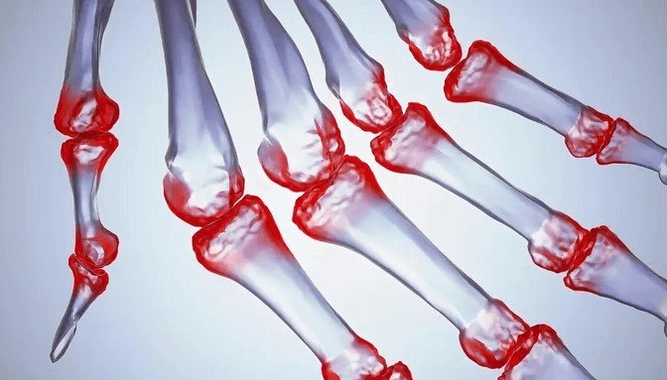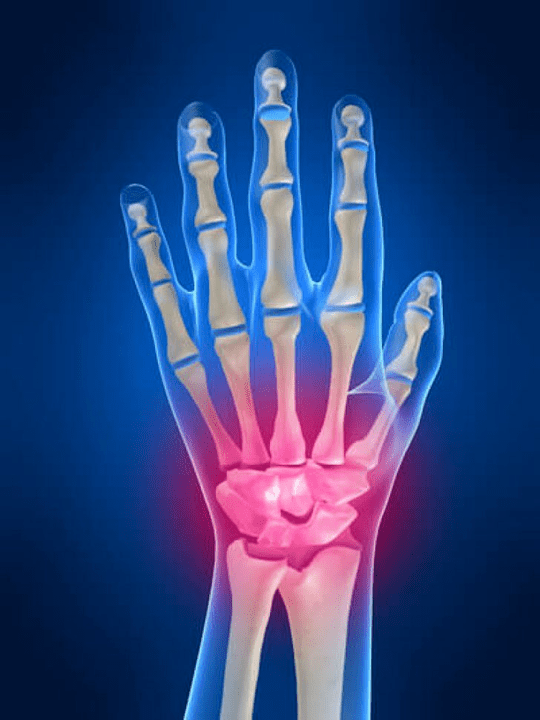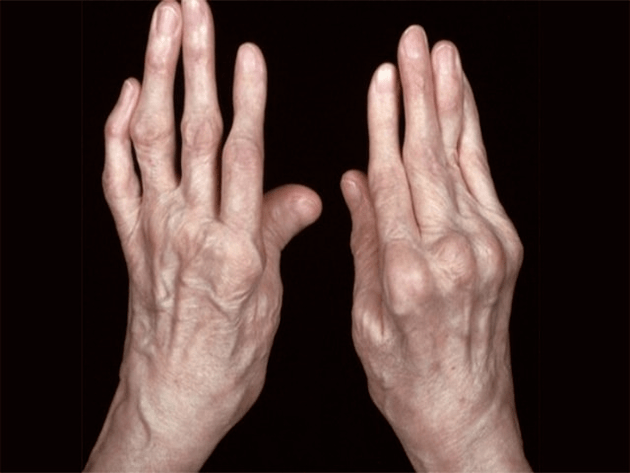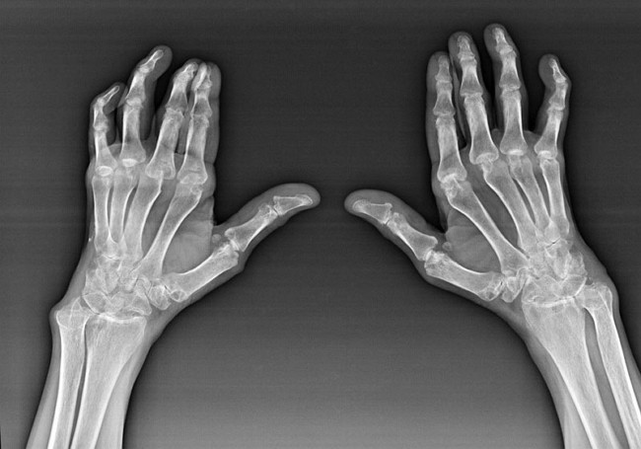
Joint painFingers are an indispensable sign of any joint pathology in which the structural components of these joints are damaged.First, pain in these joints may be associated with various autoimmune diseases (Systemic red gloss, rheumatoid arthritis, psoriatic arthritis and more.) in which the immune factors cause damage to their own joint tissues.
The next main reason that can startpainThere may be injuries in the joints of the fingers (bruises, dislocations, bone fractures, ties).The soreness in these joints can also be provoked by degenerative changes occurring in their joint tissues.This can often be observed in osteoarthritis.
Anatomy of the joints of the arm
All joints of the hand are customary to be divided into the following groups:
- wrist wrist;
- wrist joints;
- Carpal-skewer joints;
- inter -learned joints;
- Parliamental-Falax joints;
- Interfalax joints.
Wrist
The junction is formed by the bones of the proximal bones (upper) A number of wrists (Triadic, semi -moons, scaphoid bones) and distal areas of radiation and elbow bones.The bone of the elbow is not directly related to the bones of the wrist, but with the help of distal (Less) The article disc.This structure separates the wrist cavity of the joint from the distal cavity (Less) Your own joint.
Wrist joints
The wrist joints are represented by three types of joints.The first form includes those joints that are located between the bones of the upper part (Skafoid, half -mone, trineedrical, peas -forming) or the bottom row (shaped -shaped hook, trapezoidal, bone capture).These joints are called interchangena joints.The second type is ranked such -the named middle pen.This joint has a S-shaped shape and is formed due to the bones of the upper and lower rows of the wrist.The third type includes the joint of the pea.Through this joint, the trinendrian bone is connected to the pea.
Foam joints
Capal-panel joints connect the bones of the wrists and metacarpal bones.These joints are formed by the contact of proximal edges (grounds) Metacarpal bones and distal sections of carpal bones belonging to the second row.The joint carpal joints include two main joints.The first is the joint joint of the thumb.It is formed by the binding of the first metacarpal bone to bone capture.
The second is the ordinary joint for carpal paths for the other compounds of carpal-pyronine between the second, third, fourth, fifth metacarpal bones and trapezoids, bones of the head and partially, a section of bone capture.The joined joint is separated from the common carpal joint.Which is why more active movements are possible than other carpal paths (which are included in the common carpal path joint) which are considered to be stuck.Carpal panel joints are strengthened by strong joint capsules as well as bonds (Reverse and palm ties).
Interpretation
The lateral surfaces of the second, third, fourth and fifth metacarpal bones, when binding to each other, form interprex joints.These joints have separate joint capsules that approach the capsules of the joints of the carpal paths, are connected to them.In addition to the capsules, these joints have a ligament apparatus represented by the metacarpal ligaments of inter -hazard, as well as the posterior and palmar pairs of ligaments.The interperlune joints are attributed to the stuck joints of the hand, as the joint surfaces of the bones that form these joints have a flat shape.
Parleen-Phalanx joints
Parleus-Phalanx joints are compounds between distal (less) with the ends of metacarpal bones and proximal (upper) areas of the first phalanges of the fingers.Each finger of the upper limb has its own metacarponal joint.In this way, there are five metacarpal phalanx joints on each hand.
Interphalax joints
Interpophangex joints are formed by the combination of adjacent phalanges of each of the fingers.Big (first) the finger has only one interphalaced joint as this finger has only two phalanges (proximal and distal).The remaining fingers of each of the hands have two interphalalic joints.
The first one is located between the first (proximal) and the second (average) fingers and called proximal phalanges (upper) Interfalang becomes.The second forms the relationship between the average (secondly) and the last (distal) Finger phalanges.The second interphalange joints are called distal interfalaited joints.The Interfalax joints are strengthened with collateral and palmar connections.These joints belong to the block joints whose movements are only possible around the front plane (Fighting and bending).

What structures can be inflamed in the joints of the hands?
Inflammation is a typical pathological process characteristic of these tissues and organs that have been damaged for some reason.It is worth remembering that in most cases any disease (For example gout, rheumatoid arthritis, etc.) or trauma that damages the joints of the hands to one degree or another affect not only the staccular but also the peroster (nerves, muscles, tendons, subcutaneous fat, skin) structures.
The following joint structures can be inflamed in the joints of the hands:
- joint cartilage;
- Squeezing bone tissue;
- joint capsule;
- Joint links.
The causes of pain in the joints of the arm and fingers
The main share of the causes causing pain in the joints of the arm and fingers is occupied by mechanical injuries (Fractures, dislocations, bruises and more.) and systemic autoimmune diseases (Rheumatoid arthritis, systemic lupus erythematosus, psoriasis and more.).In addition to these causes, soreness in the joints of the hands can cause diseases associated with metabolic disorders (For example, gout, osteoarthrosis).

There are the following main causes that cause pain in the joints of the arm and fingers:
- bruising of the arm and fingers;
- brush bone fracture;
- brush dislocations;
- Hand connections lesion;
- rheumatoid arthritis;
- Kinbeck disease;
- reactive arthritis;
- gout;
- Psoriatic arthritis;
- Synovitis;
- osteoarthrosis;
- Red Lupus system.
Bruising a brush and fingers
Blue is one of the types of closed injuries in which there is a soft tissue damage (muscles, tendons, nerves, skin) And there are no wounds at the place where the main effect of the traumatic factor is directed.The bruises of the soft tissue of the arm and fingers are very rarely isolated (separately) from bruising of the joints of the arm and fingers.Therefore, mixed symptoms were found in this type of injury, indicating both the damage to the joints of the arm and the periartilla lesion (Perihuman) fabrics.The brush and fingers bruises are usually found when falling on the arm, damaging it with a dull object, with its compression or pinching.
Quite often the bruises of the cystic zone lead to damage to the main trunks of medium, radial, elbow nerves (which innervates the area of the arm and fingers), which is immediately manifested by the loss of sensitivity to the skin, and in some cases even the disappearance of the motor functions of the fingers.
The inflammatory edema of the joints and perhaven structures develops as a result of the expansion of multiple vessels that they are blood supply.This edema is one of the reactions of inflammation that occurs in response to tissue damage during bruising.
Bone fracture
Quite often the cause of the pain in the joints of the arm may be different fractures of his bones, as these bones are registered directly in the formation of joint surfaces.Depending on the anatomical position of the damaged bone, all fractures are divided into three main groups.The first group includes fractures of the wrist bones.The second includes fractures of tubular metacarpal bones.The third group includes fractures of the bone of the phalanges of the fingers.
The most common places of damage in the carpal zone of the brush are semi -mounges and scaphoid bones.Breaking of these bones occurs during falls on the brush and is accompanied by pain in the wrist area and middle joints of the wrist.Pain syndrome can also be observed in places for anatomical localization of these bones.
The most common fracture of the ends of the metacarpal bones is a fracture of the base of the first metacarpal bone (one that is attached to the bones of the bones of the thumb).With this injury, edema and soreness occur in the area based on the first metatarsal bone, as well as in this part of the joint of the carpal model, which is directly adjacent to it.The thumb with such a fracture is shortened, bent and leads to the palm of your hand.His movements are limited.
The fractures of the brush phalanx are accompanied by deformation, reduction of the length of the fingers, the loss of their function, acute pain and swelling in their inter -phalax joints and perhaps -human tissues.With fractures of finger phalanges with bone fragments displacement, palpation (palpation) You can identify their swelling of the palmar surface of the brush and on the back, on the contrary, hole or insulation.These fragments are usually movable, close to them you can often find subcutaneous bleeding (hematomas).
Brush dislocation
Dislocation is a pathological condition in which the areas of the bones that form each joint exceed its anatomical limits, which thus manifest themselves by complete or partial loss of the function of this joint.In addition to impaired joint function during dislocations, severe pain in the affected joint, swelling and local fever are also detected.During the dislocations of the brush, the appearance of swelling is explained not only by the presence of inflammation in the damaged perhaps -human tissues, as well as by the structures of the joint, but also with the convexity of the radiated bone.
The most frequent types of brush dislocations
| The name of the dislocation | The mechanism of dislocation | Which is astonished? |
| A true brush dislocation | The article surfaces of the bones of the wrist are displaced relative to the surface of the joint of the radial bone to the palm or in the back of the arm. |
|
| Perilunar dislocation | The bones of the wrist and the rest of the brush are displaced relative to lunch and radial bone in the back of the brush. |
|
| Bone dislocation | At the same time, the scaphoid bone shows the dislocation in the radiation side in parallel (on the same plane) to the nearby bones of the wrist.Sometimes it can shift in the palmar side, that is, move to the bone palm, as rarely on the same side of the trapezoidal bone. |
|
| Semi -moune dislocation | In the direction of the palm, there is a slide of half the lunar so that the space at the site of this bone remains not occupied.He is gradually occupied by the bone of the head, penetrating here from the second row of the bones of the wrist.This dislocation is a complication for self -regulation of the dislocation of the periloval. |
|
| Dislocation of the first metacarpal bone | The joint surface of the base of the first metacarpal bone is shifted to the joint surface of the bones in the radiation side, up (proximal) in the same plane with the bones of the wrist.In this way, the thumb is pulled a little back to the wrist. |
|
| Dislocation of finger phalans | There are dislocations of the fingers in the metacarpophalangeal joints and inter -phalax joints.In the first, joint surface of the proximal phalanx of the fingers (Along with the whole finger) displaces against the joint surface of the metacarpal bones.The second has a displacement between the bones of the phalanges of the finger itself.There are usually dislocations on the back and palm of the phalanges of the fingers. |
|
Damage to hand ties
The lesion of the connections, along with the brush bruises, is attributed to closed traumatic injuries.This pathology is mainly found with excessive extension of the arm, fingers in any direction.The main types of lesions of a bunch of brush are their stretching and tearing.When stretching in the area of damage, a slight re -tension and partial rupture of the connective tissue fibers are observed.By rupture of the connections, the whole ligament is divided into two endless ends.
The following major types of brush links are distinguished:
- rupture of the radial collateral ligament of the wrist;
- rupture of the elbow collateral ligament of the wrist;
- rupture of gripping connections;
- rupture of the lateral ligaments of the metacarpal phalanx joints;
- Rupture of the side connections of Interfalang joints.
Rheumatoid arthritis
Rheumatoid arthritis is a disease in which the human immune system damages the body's own tissues.In other words, rheumatoid arthritis is an autoimmune pathology.This disease is also systemic as many tissues are affected by it (Muscles, joints, vessels, etc.) and organs (Heart, kidneys, lungs, etc.) in the body.
Despite the fact that rheumatoid arthritis is a systemic disease below it, to a greater extent the joints suffer while the lesion of other tissues and organs is in the background.In this disease, almost all types of brushes may be affected (may be affected (wrists, carpal paths, metacarpal-phalanx, inter -phalax joints).The lesion is usually symmetrical (These.The same joints are affected) On both hands, accompanied by swelling, pain in damaged joints.In the morning, while lifting from the bed, there is some stiffness in the affected joints, which can last about 1 hour and then disappear without a trace.
Quite often with rheumatic arthritis near the affected joints of the brush (More often the piano-fagloga, the inter -phalax joints) Rheumatoid nodes appear.They are a rounded formation located under the skin.On the brush, these entities occur most often on the back.In palpation, they are dense, inactive, painless.The number of them can vary.
Kinbeck
Kinbeck's disease is a pathology in which the crescent carpal bone of the brush is affected.The disease develops as a result of long -term physical overload of the palms of the hands.This is usually found in specialists of construction professions - plasters, Freemason, carpenters and more.Excessive physical activity of the palms of the palms of the palms most often this bone as it occupies the central position in the wrist.Most often, during Kinbeck's disease, the brush on one hand is affected and as a rule the main (The right hand is damaged, the left hand is damaged).
Reactive arthritis
Reactive arthritis is a pathology of the immunopathological genesis in which its own immune system attacks various joints in the body, which is why autoimmune inflammation develops in them.Unlike other autoimmune diseases (For example, rheumatoid arthritis, systemic lupus erythematosus, when the onset of infectious origin is taken) In reactive arthritis, a clear link between the infection is monitored (and more special, intestinal or urogenital) and the development of joint lesions.
Also, with this pathology, lymph nodes can enlarge and fever can occur.When reactive arthritis switches to chronic form, over time, patients may indicate signs of kidney disease, heart and muscle atrophy, bursitis may occur (Inflammation of the perosemant bags), Tendovaginites (Inflammation of the vagina of the tendons) others.
Gout
Gout is a disease based on the development of uric acid accumulation in the body and its deposition in the form of salts in the joints.Urralgic acid is the ultimate product of the metabolism of purine and pyrimidine foundations.They serve as the basis for the construction of DNA and RNA molecules, some energy formations (Adenosine triphosphate, adenosine monophosphate, etc.) and vitamins.
Gout pain occurs mainly in the small joints of the lower and upper limbs.In addition, in 50% of all clinical cases, the disease begins with the first plus of the legs.On the hands, as a rule, the interacting joints of the fingers are affected, more rarely - radiant joints.Gout usually damages one or more joints on one limb, sometimes the joints of other limbs are involved in the inflammatory process.
Psoriatic arthritis
Psoriatic arthritis is a pathology in which different joints are inflamed against the background of psoriasis.The development of psoriasis is based on a disorder of the interaction between the immune cells and the skin cells, resulting in the body (And especially in the skin) There are autoimmune reactions that cause inflammation.
Synovitis
Synovitis is an inflammation of the synovial lining of the joints, accompanied by damage to its tissues and the accumulation of pathological fluid in the affected joints.Synovitis is not a separate disease, but more recently serves as a complication of other diseases.It can occur with endocrine, allergic, infectious, autoimmune pathologies, brushes, etc.
Osteoarthrosis
Osteoarthritis is a disease in which there is a violation of the processes of formation of normal cartilage tissue in different joints.These processes are impaired under the influence of some external and internal predisposing factors.They may be constant joint injuries, prolonged physical activity (At work, in everyday life, during the sport), heredity, other joint diseases, etc.
The joints of the fingers are inflamed with this pathology because in the periarticular (Perihuman) Tissues occur inflammation, nerves are affected.A characteristic characteristic of osteoarthritis is the relationship of pain with physical activity.Siteness in the joints occurs mainly in and/or after severe physical overload and disappears at rest or after rest.
Red Lupus system
Systemic lupus erythematosus is an autoimmune pathology in which in the human body there is a production of an immune system of autoimmune antibodies, attacking various structures of cells and tissues.In particular, it observes the production of SO -attached anti -core antibodies that damage cell nuclei and DNA and RNA molecules.Different tissues and organs are affected with red lupus - skin, vessels, heart, pleura, pericardium, kidneys, joints and more.
The Red Lupus system is constantly linked to other additional signs - weakness, weight loss, fever (Improvement of body temperature).However, special symptoms are of the most important, without which the diagnosis of red lupus is not made.These special signs are photodermatitis (inflammation of the skin under the influence of sunlight), discoid rash (The appearance of the neck of the neck, the chest of the red papules), a lupoid butterfly (The appearance of red spots on the skin near the nose), erosion in the oral cavity, kidney damage (Glomerulonephritis), serosites (Inflammation of serous membranes) others.
Diagnosis of causes of pain in pain

The hands of the pain in the joints of the arm are engaged in the diagnosis and treatment of the causes of pain, mainly a traumatologist and a physician.To diagnose similar causes, these doctors use mainly clinical (History collection, external inspection, palpation and more.), radial (Radiography, computed tomography) and laboratory (General blood test, biochemical blood test, etc.) Examination methods.
Depending on the cause of pain in the joints of the arm, the whole diagnosis can be divided into the following sections:
- Diagnosis of traumatic brush injuries (bruises, dislocations, fractures, ties);
- diagnosis of rheumatoid arthritis;
- Diagnosis of Kinbeck Disease;
- diagnosis of reactive arthritis;
- gout diagnostics;
- diagnosis of psoriatic arthritis;
- Diagnosis of synovitis;
- Diagnosis of osteoarthrosis;
- Diagnosis of systemic lupus erythematosus.
Diagnosis of traumatic brush injuries
When brush injuries, you should consult a traumatologist.The basic diagnostic methods used in medical practice to identify traumatic brush injuries (fractures, dislocations, connections, bruises) are an external examination, anamnesis, radiation methods of examination (Radiography, computed tomography).
Collecting anamnestic data allows the doctor to identify incidents that lead or may cause brush injury.The history of the anamnesis is also used to clarify the symptoms that bother the patient.During an external examination of the brush, it is possible to detect swelling, hematomas, its deformation, restriction of joint mobility.With the help of palpation, the doctor reveals the presence of pain, a violation of the anatomical shape of the joint, damage to the ligaments.Radiation methods of research (Radiography, computed tomography) They allow you to confirm the diagnosis, as during their use the mechanical damage to the anatomical brush formations are clearly visible.
Treatment of pathologies that cause inflammation of the joints of the hand

To treat the causes of pain in the joints of the arm and fingers doctors, first of all, prescribe various medicines (Anti -inflammatory, painkillers, anti -rehabetas drugs and more.).In some cases, they combine the use of these products with physiotherapy procedures.Traumatic brush damage is most often treated surgically or applied to the affected upper limb of the gypsum dressing.
To relieve pain and relieve inflammation, first aid may be the use of external NSAIDs.The drug selectively blocks COO-2 and acts directly on the pain source.It is quickly absorbed thanks to a special texture, leaves no trace of clothes, has a pleasant odor.
Depending on the pathology that causes inflammation in the joints of the arm, all treatment can be divided into the following parts:
- Treatment of traumatic brush injuries (bruises, dislocations, fractures, ties);
- treatment of rheumatoid arthritis;
- Treatment of Kinbeck disease;
- treatment of reactive arthritis;
- treatment of gout;
- treatment of psoriatic arthritis;
- Treatment of synovitis;
- treatment of osteoarthritis;
- Treatment of systemic lupus erythematosus.






















